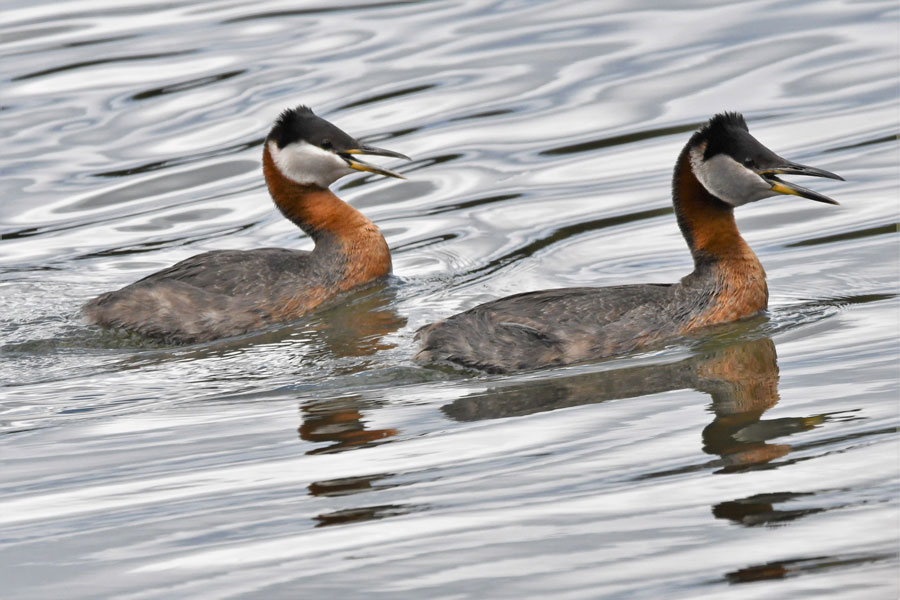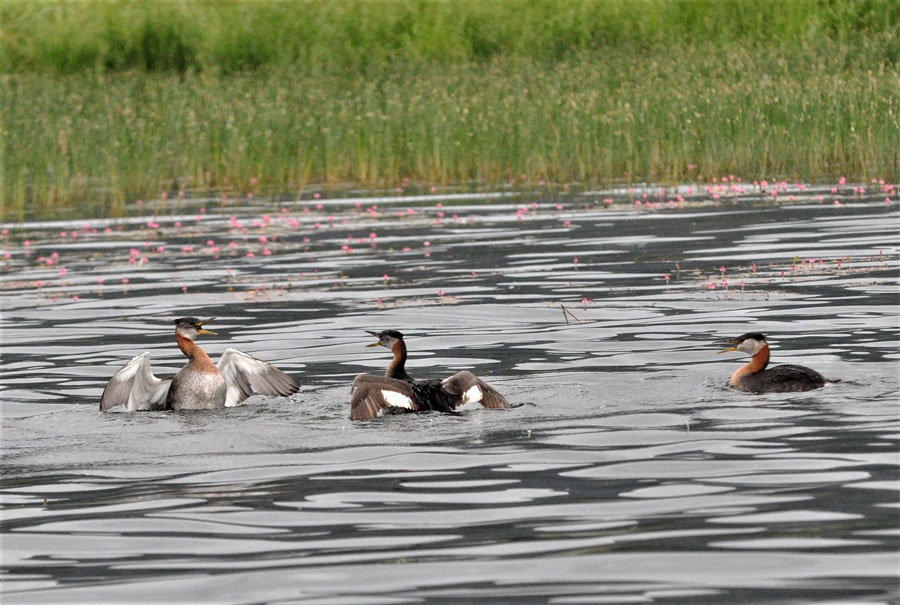Red-necked grebes nest on Silver Lake
Published at
Stopping at the Silver Lake Outlet in Harriman State Park, I watched the male, Red-necked grebe surface with a three-inch Red-sided shiner in its beak. It started swimming with the flipping fish toward the patch of cattails on the southeastern bank behind the yurts. Near the edge of the cattails, I saw the female hunting the floating moss bed as a young chick followed her.
When Dad made it to the pair, the chick quickly received the brunch, swallowing it whole while Dad quickly headed back out to the middle of the lake to try to capture another snack. Mom and the babe continued hunting for and eating water insects.
I didn’t have much time to try to get closer so a week later when I had to run to Island Park again, I planned on spending time trying to get closer to them. Last week I discovered that the pair of Red-necked grebe had two chicks as I saw them riding on Mom’s back.

Last spring this couple was the first of that species that I have ever seen on Silver Lake and was surprised to watch them as they went through their different “ceremonies” of dating. They have a “weed ceremony,” a “discovery ceremony” and a “greeting ceremony.”
All these activities I witnessed before they began nesting. The only normal dating activity that I did not see was the male protecting his significant other from other aggressive males; these were the only two adult Red-necks I witnessed on Silver Lake.
They built their floating nest in the cattails out of material that they gathered as they prepared for their new family. The nest base was about three to four feet across and anchored to cattails or other aquatic reeds so it can float as the water fluctuates and will not flood.

On Henrys Lake there are between 50 to 100 Red-necked grebes. Here, while protecting the nest site, these birds do not often attack intruders on the water surface or from the air, they dive and attack from under the water. If they attack on the surface, usually the male but sometimes both will attack the offender, chasing it away from their territory.
Usually, two to four chicks are hatched and it isn’t long before the “zebra” looking chicks are feeding and riding piggyback on the parents. If danger appears, the chick will latch on to the parent’s feathers with their bill as the adults dive to escape. I have seen as many as three chicks riding on a parent’s back as it dives to avert danger.
One of the strange activities these birds have is that they eat their own feathers and even feed the chick’s feathers. It is unknown why they do this, but a theory is that the feathers protect the lower intestines from the undigestible portions of the fish they eat.
This pair at Silver Lake probably originated from the flock that summers on Henrys Lake where 30 to 40 pairs nest along the western shoreline reeds and cattails. Red-necked grebes are mostly a Canadian and Alaska bird that winters along the Pacific Coast but migrates east to fresh water, to inland lakes to spend the summers. The Great Lakes has large numbers of these birds in the summer that move to the east coast to winter there. Island Park and a small flock in Yellowstone National Park are the most common areas near the Upper Snake River Valley to view these magnificent birds and their displays.
If you are headed to Island Park, a visit to Silver Lake at Harriman State Park or west of the Cliffs and the Bill Frome County boat dock on Henrys Fork, are good places to look for these beautiful birds. They are fun to watch and learn from.

Living the Wild Life is brought to you by The Healing Sanctuary.


